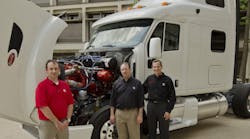This week Cummins and Peterbilt Motors Co. released some fuel economy data gleaned from the joint test vehicle both designed for the “SuperTruck” program spearheaded by the U.S. Department of Energy (DOE) – a Peterbilt Model 587 highway tractor equipped with a higher-efficiency engine and pulling an aerodynamic trailer.
And those results are pretty dramatic: a 54% increase in fuel economy, averaging nearly 10 miles per gallon (mpg), under real world driving conditions, though it’s important to note that the big rig’s combined gross weight topped out at 65,000 lbs.; some 15,000 lbs. less than the legal limit.
[Here’s an overview of the Model 587 from a few years back.]
Cummins noted that today’s long-haul trucks typically achieve between 5.5 and 6.5 mpg, so that 54% increase in fuel economy translates into savings of around $25,000 annually based on today’s diesel fuel prices for tractor-trailers clocking 120,000 miles per year. It would also translate into a 35% reduction in annual greenhouse gases per truck, the engine maker said.
In addition to the fuel economy improvements, the truck also demonstrated a 61% improvement in freight efficiency during testing compared to a baseline truck driving the same route, both OEMs reported – significantly exceeded the 50% SuperTruck program goal set by the DOE.
For context, Cummins is one of four vertical teams under the DOE’s SuperTruck project – one of several initiatives under the 21st Century Truck Partnership, which is a public-private partnership founded to try and “stimulate” innovation in the trucking industry via the combined work of government agencies, private companies, national laboratories and universities.
[To read about Freightliner Truck’s work within the SuperTruck project, click here.]
Cummins, Peterbilt and their program partners will have invested $38.8 million in private funds over the four-year life of their SuperTruck program, which started in 2010, with critical support coming through awarded matching grants from the DOE’s Vehicle Technologies Program.
[Here’s a look at Freightliner’s initial “SuperTruck” work unveiled three years ago.]
The vehicle also uses a system that converts exhaust heat into power delivered to the crankshaft, electronic controls that use route information to optimize fuel use, tires with lower rolling resistance and lighter-weight material throughout, noted David Koeberlein (standing in the center in the above photo), Cummins’ principal investigator for the SuperTruck program.
Other tactics include efforts to reduce internal friction and so-called “parasitic power” – excess power the engine needs to run such things as lube and coolant pumps and air compressors, he explained.
Meanwhile, Peterbilt and its partners focused on improvements to the drivetrain, the idle management system, weight reduction and vehicle climate control – using transmission work conducted by Eaton Corp. to improve engine “down-speeding” for additional fuel economy benefits.“Aerodynamics has been a significant contributor to the efficiency gains,” added Scott Newhouse, senior assistant chief engineer of product development at Peterbilt. “We are very pleased with what our team has been able to accomplish using a comprehensive tractor-trailer approach.”
The companies added that “SuperTruck” testing will continue in 2013 using a new Peterbilt Model 579 that both Cummins and Peterbilt are confident will take what’s been achieved so far to even higher levels, with this next series of tests addressing how a tractor-trailer is used over a 24-hour period – including when drivers are at rest but still need power for such things as air conditioning and small appliances.
It’ll be neat to see what they might achieve.





